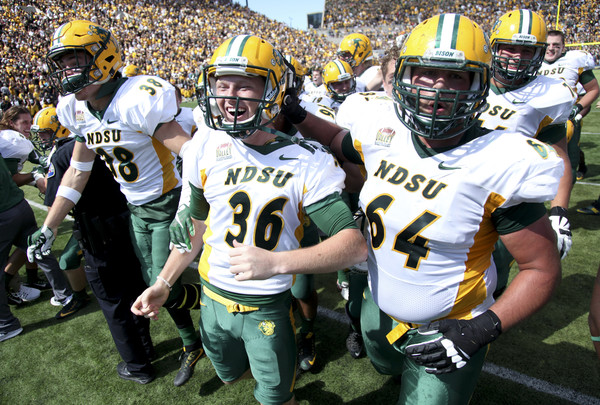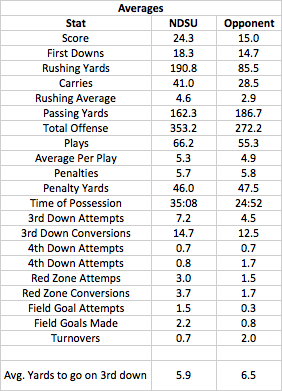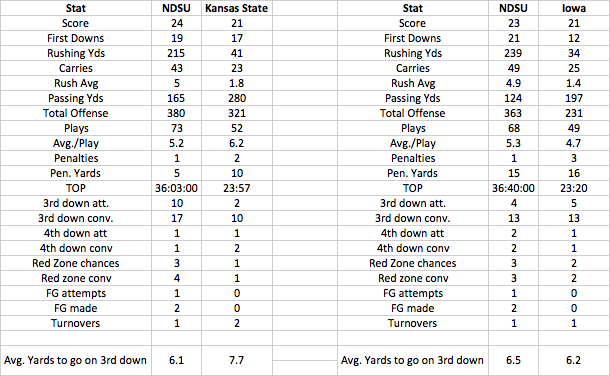
North Dakota State Uses Familiar Blueprint To Beat FBS Foes
Perhaps you heard the North Dakota State Bison defeated the #13 Iowa Hawkeyes 23-21 on Saturday. The Bison went in as 14.5 points underdogs and defeated the mighty Iowa team that went 12-2 and played in the Rose Bowl last season. This was the sixth straight victory for North Dakota State over an FBS opponent. Below is the North Dakota State record and future games versus FBS teams.
#NDSU record versus #FBS opponents:#FCS #CFB #FearTheFCS pic.twitter.com/opaEwOp3Hk
— Fear The FCS (@FearTheFCS) September 18, 2016
So how does North Dakota State consistently defeat their FBS foes? Well, let’s take a closer look.
Below are the averages between the Bison and their last six FBS opponents, which happens to be their current win streak against the FBS.
So how do the Bison defeat six straight FBS teams? Stop the run, force third and long situations, control the ball, and win the turnover battle.
First, the Bison like to stop the run and that is clear from the rushing yards given up (85.5 per game) and yards per carry average (2.9 per attempt). In fact, their highest rushing total allowed in the six games was 168 yards to Minnesota in 2011. Every other game has seen the Bison allow no more than 102 yards. The highest total yardage allowed by NDSU in the six games was 321 to Kansas State in 2013. The other five games all saw the Bison hold their opponent to fewer than 300 yards.
Notice at the bottom of the picture where it mentions the average yards to go on third down. Some calculations were needed, but the end result is clear: the Bison like to get their opponent in third and long, which becomes and obvious passing down. Common sense says it is a lot easier to prepare when you know what is coming from the other offense. The Bison also did better to defend third down as well allowing roughly 36% (4.5 converted out of 12.5 on average per game). The Bison converted about 50% of their third downs on offense, which helps immensely with time of possession.
Next up is controlling the ball and the Bison do this incredibly well. They held the ball for an average of 60% of the game and that is not an aberration. They won the time of possession battle in all six victories and the last four (Colorado State, Kansas State, Iowa State, and Iowa) saw them hold the ball above their 60% average. The longer NDSU holds the ball, the longer the opposing defense stays on the field and gets tired. Tiredness can lead to mistakes and frustration. It is demoralizing for a defense to be constantly battered without much rest and the Bison are great at this part.
Finally, we have reached the turnover part. The averages say the Bison have less than one turnover per game compared to two for their FBS opponent. Turnovers lead to more possessions, which leads to higher time of possession, more running, and basically everything NDSU loves to do. The Bison have not been perfect as they registered one turnover in four of the six games. The difference? The Bison never lost the turnover battle in the six wins and their “worst” result was against Iowa on Saturday when both teams finished with one turnover.
There is still more to the puzzle that is part of the blueprint, but they are not separated out in the box score. Those pieces would be the coaches game plan and execution by the players. How do you account for the things coaches see on film? How about when the player is in the right spot at the right time? Sure, it might end up as a turnover, but what about a blitz that is called out and picked up or a certain formation that is run? The Bison have been well prepared by Craig Bohl and Chris Klieman, but the players deserve credit for their execution too. They did not become 5-time FCS National Champions solely due to luck or by accident.
Iowa = Kansas State?
The light did not go on watching the North Dakota State-Iowa game as to how similar this game was to the Kansas State victory in 2013. NDSU took a 7-0 lead in the first quarter in both games, K-State and Iowa both responded by scoring at least two touchdowns, and the Bison needed a score late in the game to win. In addition, North Dakota State came in as a double digit underdog and reigning FCS Champions.
While the overall story arc was similar between the two games, some of the stats (and execution by the Bison) were as well. Below are the game stats for both North Dakota State at Kansas State in 2013 and North Dakota State at Iowa on September 18.
Look at those rushing stats. The Bison averaged 227 yards per game and gave up only 37.5. 37.5 yards per game against two upper level Power 5 conference opponents. Look at the time of possession. NDSU held the ball for 60%+ in each game. They ran about 40% more plays while also committing a grand total of 2 penalties for 20 yards in the two games. Coincidentally, the scores were nearly identical at 23-21 against Kansas State and 24-21 against Iowa.
Want to consistently pull upsets like North Dakota State? There is the blueprint and all you need to do is execute it like the Bison. Easier said than done.
Let’s enjoy this incredible run by the Bison both against FBS teams and in the FCS because these type of streaks do not happen very often.

